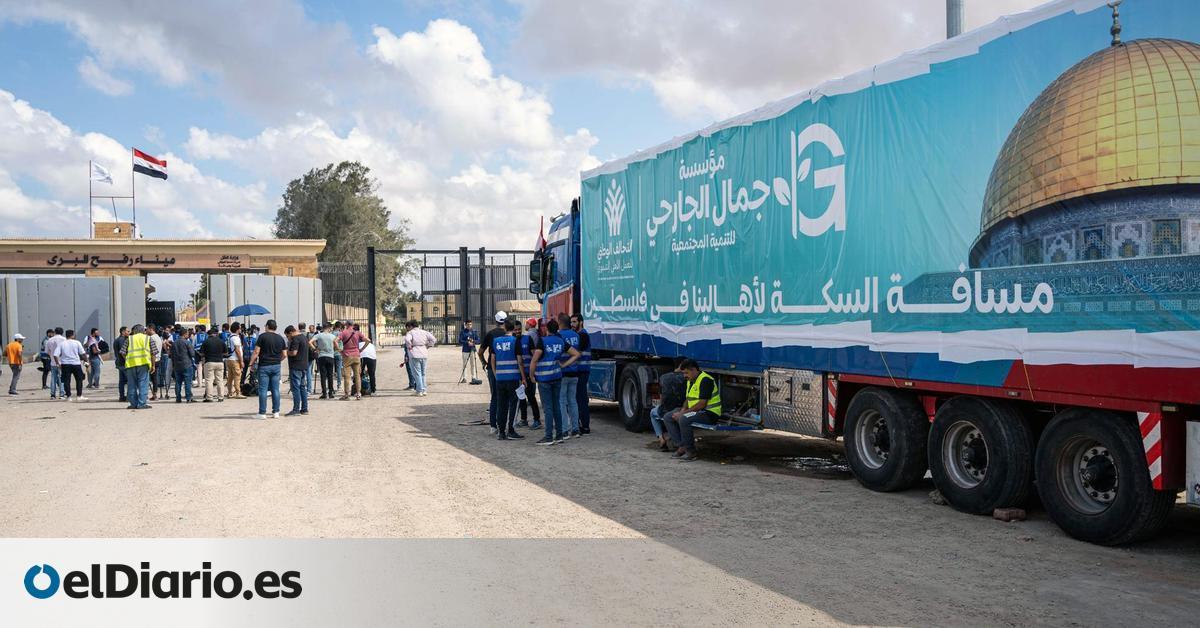
Repair the road, destroyed by Israeli air strikes, to get the first batch of aid into Gaza as soon as possible. It is the first step of the operation that began this Thursday to bring water, food and medicine to the Palestinians in the Strip, subjected to a total blockade by Israel during the 13 days of war between Israel and Hamas. While UN agencies warn of the worsening humanitarian crisis and urge a rapid response, the agreement reached between the US, Egypt and Israel will only allow access, for the moment, for an initial quota of 20 trucks. They will begin to arrive, at the earliest, this Friday, according to the White House.
Only the green light has been given for the passage of a first group of 20 trucks, but more than 200 vehicles and nearly 3,000 tons of aid are waiting near the Rafah border crossing, the only connection between Egypt and the Strip, according to what he said. Khalid Zayed, the head of the Red Crescent for North Sinai.
The UN’s objective is to ensure that around 100 aid trucks a day can once again enter Gaza, as they did before the last war and the total closure imposed by Israel. The 20 vehicles agreed upon appear, therefore, insufficient to supply the 2.3 million residents of Gaza, most of whom already depended on humanitarian aid before the current conflict began, due to the blockade that the population has suffered since 16 years ago.
For the UN Office for the Coordination of Humanitarian Affairs (OCHA), this first block of aid is not enough for the enormous needs accumulated among the Gazan population after 13 days of war and total blockade of the supply of water, food, medicine and electricity. The United Nations agency calls for recovering a stable system to address the humanitarian crisis in the overcrowded Gaza Strip.
“We urgently need a mechanism agreed by all relevant parties that allows for the regular provision of emergency needs throughout Gaza so that the level of aid distribution returns to what it was before these terrible weeks,” said Martin Griffiths, Secretary General of OCHA, this Wednesday. The standard required by the UN in the Strip is to send “100 trucks a day” to provide aid throughout Gaza to people in need “and not just a part of them: ”We have to return to that level of ambition “.
The first phase of the operation consists of repairing the roads, covering the potholes left by the Israeli bombings, so that the trucks can cross the Rafah crossing. This task is expected to be carried out throughout this Thursday, for about eight hours, with the intention that the first aid supply can enter the Strip on Friday.
Once the first distribution of the first 20 trucks of food, water and food has been made, the plan is to continue with more aid shipments, as long as the supplies reach exclusively the civilian population. If Hamas confiscates the aid, the operation “will end,” as Biden detailed after his visit to Israel.
As Israel also assured, its Army “will not hinder” the deliveries as long as they reach the civilian population in the southern Gaza Strip and ensure that they do not fall into the hands of Hamas militiamen. Egyptian Foreign Minister Sameh Shoukry has reported on Al-Arabiya-TV that the supplies will enter under UN supervision.
“We hope it is not a failure,” the regional representative of the World Health Organization (WHO), Richard Brennan, said this Thursday about the aid agreement. According to him, he has warned, there are “many complexities to launch this aid operation.”
“This is not a sprint race. This is just the beginning. This is a marathon. A true marathon,” added Brennan.
Waiting
In Al Arish, an Egyptian town near the Rafah border crossing, humanitarian aid collected by United Nations agencies and different countries in the region has been waiting for days for the final green light. Meanwhile, Gaza “is running out of food,” warns the World Food Program (WFP).
The UN agency has 951 metric tons of emergency food prepared in Al Arish. “We urgently need safe access to deliver this food to the families who need it most,” said WFP spokesperson Abeer Etefa.
At the Rafah border crossing, hundreds of Egyptian volunteers wait for the moment when they can access Gaza to deliver humanitarian aid. “I have come here to come in to bring help to our Palestinian brothers. “I am very excited to enter as soon as possible,” Akram Mounir, one of the volunteers, told EFE. He comes from the Egyptian city of Al Mansura, located in the north of the country, but has already been in Al Arish for a week, a place designated for the unloading of humanitarian aid. “I’m not afraid, I’m here and I’ll be here for even a month, two or three. I will not turn back without all this happening,” another young man, Abdelrahman Farid Gomaa, told the agency.
In recent weeks, tons of aid have arrived at Al Arish airport, from Egypt (2,000), Turkey (68), Jordan (12), the United Arab Emirates (another 12) and Tunisia (11.5), according to the Egyptian press. .
Relatives of some of the nearly 200 people who were taken hostage during the Hamas attack had long opposed the entry of humanitarian aid into Gaza. Following the agreement, the Hostages and Missing Families Forum has criticized the decision to allow the supply of water, food and medicine to the civilian population. “Children, babies, women, soldiers, men and the elderly, some with serious illnesses, wounded and shot, are kept underground like animals […] but “the Israeli government pampers murderers and kidnappers,” they say in a statement.
The Government in Cairo has been pressing for days for the aid accumulated in the middle of the desert to begin entering Gaza, while defending its refusal to allow Gazans to enter Egyptian territory. On Wednesday, President Abdelfattah Al Sisi was more blunt than ever in a press conference with the German Chancellor, Olaf Scholz, visiting the Egyptian capital. “Preventing water, electricity, fuel, aid from entering [a Gaza], the ultimate objective is to displace Palestinians from the Strip to Egypt. We reject the eradication of the Palestinian cause and its displacement to Sinai,” denounced Al Sisi, who has been warning of the consequences that a mass exodus of Gazans to Egyptian territory would have.
Intense Israeli bombing of Gaza, from air, sea and land, continues almost uninterrupted after the Hamas attack ten days ago. Before the latest massacre, the death toll already rose to 3,785 in the strip, of which 1,524 are minors, according to Gaza authorities, while hundreds of more people are missing and believed to be trapped under the rubble. At least a million people have been forced to flee their homes in just one week.
With information from AP and EFE.
Source: www.eldiario.es

